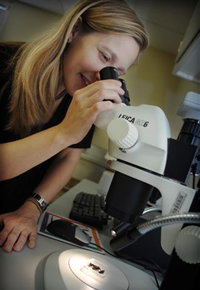Ancient Textiles Offer Insight Into Native American Life

Going down any red carpet these days, a celebrity is always asked, “Who are you wearing,” referring to the clothes’ designer.
But in her research of ancient textiles, Dr. Amanda Thompson is more interested in finding out what people were wearing. Thompson, a professor in the department of clothing, textiles and interior design at The University of Alabama, has been examining textile fragments found at Alabama’s famous Native American burial grounds at Moundville Archaeological Park – artifacts that other researchers and archaeologists have previously ignored.
“They’ve just been sitting, waiting for someone to look at them,” Thompson says. Some of the artifacts she examines are small pieces of textile, only 2 centimeters. These textiles were preserved in a charred state after being exposed to low temperature fires.
Sometimes, all that remains is the textile’s pseudomorph – a transformation that occurs over time and leaves the textile structure intact. The pseudomorphs that Thompson typically studies occur when material is transformed and preserved through contact with metallic objects buried with the person.
Under both light and Environmental Scanning Electron Microscopes, she analyzes the textiles and pseudomorphs to determine yarn structure, fabric structure, and, whether the artifact was made of protein fiber from animals or plant fiber.
Thompson has presented her research to the Society of American Archeologists. She’s discovered, among other things, that the recovered Moundville textiles are made from plant fibers, and she’s determined the yarn size and the twining structure of the fabric.
Further Reading